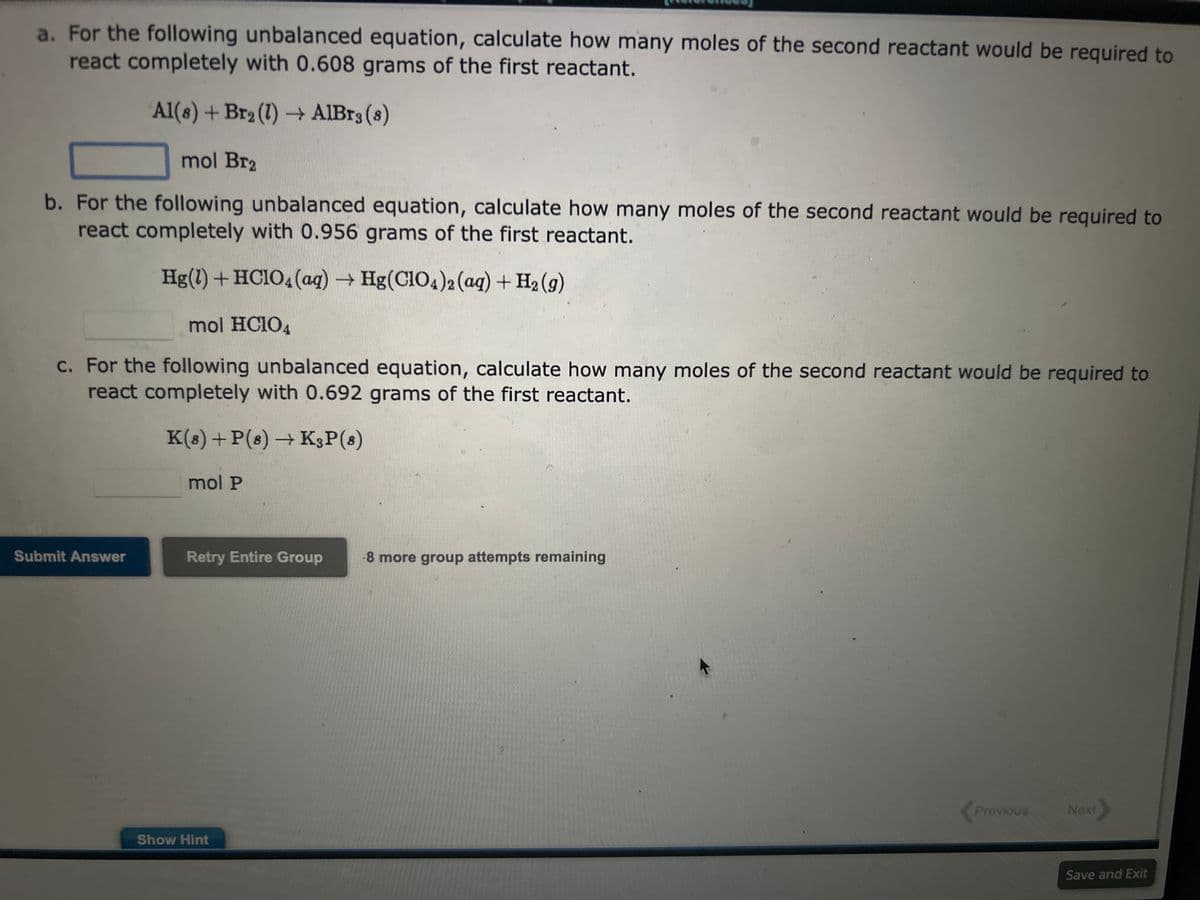a. For the following unbalanced equation, calculate how many moles of the second reactant would be required to react completely with 0.608 grams of the first reactant. Al(s) + Br₂ (1)→ AlBr3 (8) mol Br₂ b. For the following unbalanced equation, calculate how many moles of the second reactant would be required to react completely with 0.956 grams of the first reactant. Hg(1) + HCIO4 (aq) → Hg(ClO4)2 (aq) + H₂(g) mol HC104 c. For the following unbalanced equation, calculate how many moles of the second reactant would be required to react completely with 0.692 grams of the first reactant. K(8) + P(8)→ K3P (8) mol P
a. For the following unbalanced equation, calculate how many moles of the second reactant would be required to react completely with 0.608 grams of the first reactant. Al(s) + Br₂ (1)→ AlBr3 (8) mol Br₂ b. For the following unbalanced equation, calculate how many moles of the second reactant would be required to react completely with 0.956 grams of the first reactant. Hg(1) + HCIO4 (aq) → Hg(ClO4)2 (aq) + H₂(g) mol HC104 c. For the following unbalanced equation, calculate how many moles of the second reactant would be required to react completely with 0.692 grams of the first reactant. K(8) + P(8)→ K3P (8) mol P
Chemistry & Chemical Reactivity
10th Edition
ISBN:9781337399074
Author:John C. Kotz, Paul M. Treichel, John Townsend, David Treichel
Publisher:John C. Kotz, Paul M. Treichel, John Townsend, David Treichel
Chapter4: Stoichiometry: Quantitative Information About Chemical Reactions
Section: Chapter Questions
Problem 6PS: The formation of water-Insoluble silver chloride is useful in the analysis of chloride-containing...
Related questions
Question

Transcribed Image Text:a. For the following unbalanced equation, calculate how many moles of the second reactant would be required to
react completely with 0.608 grams of the first reactant.
Al(s) + Br₂ (1)→ AlBr3 (8)
mol Br₂
b. For the following unbalanced equation, calculate how many moles of the second reactant would be required to
react completely with 0.956 grams of the first reactant.
Hg(1) + HCIO4 (aq) → Hg(ClO4)2 (aq) + H₂(g)
mol HC104
c. For the following unbalanced equation, calculate how many moles of the second reactant would be required to
react completely with 0.692 grams of the first reactant.
K(8) + P(8)→ K3P (8)
mol P
Submit Answer
Retry Entire Group -8 more group attempts remaining
Show Hint
Previous
Next
Save and Exit
Expert Solution
This question has been solved!
Explore an expertly crafted, step-by-step solution for a thorough understanding of key concepts.
This is a popular solution!
Trending now
This is a popular solution!
Step by step
Solved in 4 steps with 3 images

Knowledge Booster
Learn more about
Need a deep-dive on the concept behind this application? Look no further. Learn more about this topic, chemistry and related others by exploring similar questions and additional content below.Recommended textbooks for you

Chemistry & Chemical Reactivity
Chemistry
ISBN:
9781337399074
Author:
John C. Kotz, Paul M. Treichel, John Townsend, David Treichel
Publisher:
Cengage Learning

Chemistry & Chemical Reactivity
Chemistry
ISBN:
9781133949640
Author:
John C. Kotz, Paul M. Treichel, John Townsend, David Treichel
Publisher:
Cengage Learning

Introductory Chemistry: A Foundation
Chemistry
ISBN:
9781337399425
Author:
Steven S. Zumdahl, Donald J. DeCoste
Publisher:
Cengage Learning

Chemistry & Chemical Reactivity
Chemistry
ISBN:
9781337399074
Author:
John C. Kotz, Paul M. Treichel, John Townsend, David Treichel
Publisher:
Cengage Learning

Chemistry & Chemical Reactivity
Chemistry
ISBN:
9781133949640
Author:
John C. Kotz, Paul M. Treichel, John Townsend, David Treichel
Publisher:
Cengage Learning

Introductory Chemistry: A Foundation
Chemistry
ISBN:
9781337399425
Author:
Steven S. Zumdahl, Donald J. DeCoste
Publisher:
Cengage Learning

World of Chemistry, 3rd edition
Chemistry
ISBN:
9781133109655
Author:
Steven S. Zumdahl, Susan L. Zumdahl, Donald J. DeCoste
Publisher:
Brooks / Cole / Cengage Learning

Chemistry for Engineering Students
Chemistry
ISBN:
9781337398909
Author:
Lawrence S. Brown, Tom Holme
Publisher:
Cengage Learning

Chemistry for Engineering Students
Chemistry
ISBN:
9781285199023
Author:
Lawrence S. Brown, Tom Holme
Publisher:
Cengage Learning